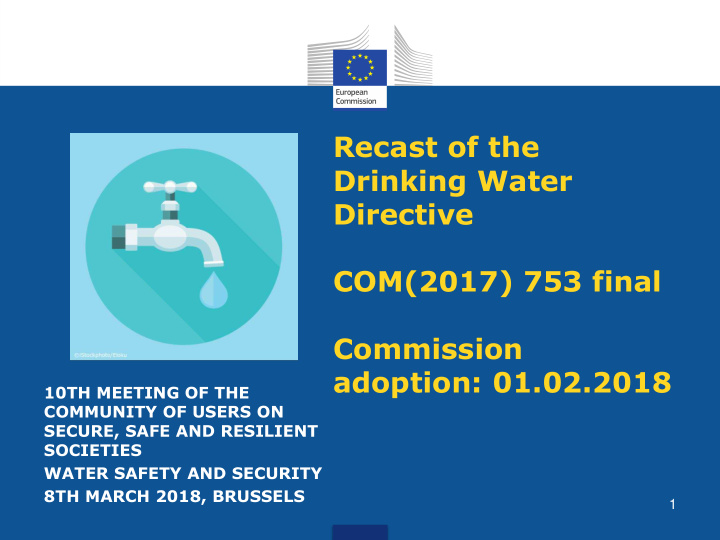



Recast of the Drinking Water Directive COM(2017) 753 final Commission adoption: 01.02.2018 10TH MEETING OF THE COMMUNITY OF USERS ON SECURE, SAFE AND RESILIENT SOCIETIES WATER SAFETY AND SECURITY 1 8TH MARCH 2018, BRUSSELS
Current Drinking Water Directive "Protect human health from adverse effects of any contamination of water intended for human consumption" Monitoring and remedial Information to Reporting to action: consumers COM 48 parameters 2
Tap water in the EU is clean 3
Confidence in tap water 4
What happened? • European Citizens Initiative Right2Water 2014 • Follow-up: Public consultation on drinking water • REFIT Evaluation Drinking Water Directive 2016 • Cooperation with WHO: recommendations • Impact Assessment Study and Staff Working Document 2017 • European Pillar of Social Rights " Everyone has the right to access essential 2017 services … including water. • Recast proposal 2018 5
What's new? Highest quality standards for materials in contact Access to water Increased Updated transparency parameters Risk-based approach 6
Cooperation with WHO 7
Main health issues to tackle Legionella Microbiological risks New and rare contaminants Substances of emerging concern 8
Risk-based approach O Point of Catchment Drinking Water L area compliance Consumer Treatment Distribution (also WFD) D N E Abstraction Supply Consumer Distribution W Proposal covers complete water supply chain 9
Confidence in tap water Core parameter list remains Updated/new Risk-based Parameters approach Improved health protection Limited costs for water suppliers Better alignment with Water Framework Directive 10
Information and transparency Essential information for Water Bill consumers on bill Additional information online Online Information Lighter and more accurate national reporting Datasets 11 11
Why transparency matters? Confidence in tap water Savings for consumers Performance of operators Investments Reduction of plastic bottles 12
Access to water Right2 Water ECI Provision on SDG 6 access to water 23 million without connection 13
Art. 13 on access to water • Measures to ensure access to water for vulnerable and marginalised groups • Measures to improve access to tap water : encourage to build infrastructure, free access in public spaces, campaigns … 14
Highest standards for materials DWD recast • Mutual recognition not working • Used by MS to impose • Domestic Distribution Risk additional testing for Assessment products and materials • Standardisation Mandate • Barrier to trade under Construction Products Regulation Current situation 15
Security - Organisational Aspects 1) Explanatory Memorandum, Chapter Consistency • Security measures: under other Union policies • Reference to 'NIS Directive' (EU) 2016/1148 on the security of network and information systems and CBRN Action Plan 2) New Provisions Risk-Based Approach (Water Safety Plan) • Safety measures will improve security • Identification of hazards affecting water bodies • Better communication authorities – suppliers • Reference EN 15975(-2) concerning security of drinking water supply 16
Security - Technical Aspects 3) Better Monitoring will facilitate detection Continuous sensor monitoring > 10.000 m 3 /day • 4) More Parameters and higher frequencies Microbiology and Chemicals • Legionella: for priority premises: effective control and • management measures to prevent and address possible outbreaks 17
Security – Management and Information Aspects 5) Introduction of very large Water Suppliers > 50,000 persons supplied • Information obligation on • Performance and management • Timeliness and adequacy of responses to problems • 6) Data sets on incidents Scale affecting >1,000 people, lasting > 10 days • Causes of incidents • Remedial action taken • => Lessons learned 18
Costs and benefits Costs Benefits 19
20
Recommend
More recommend